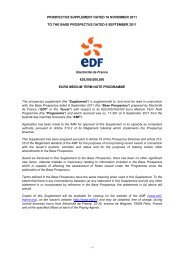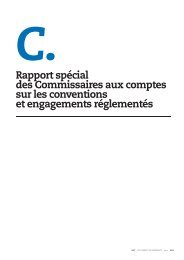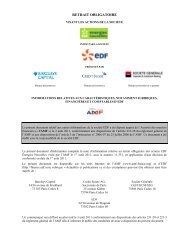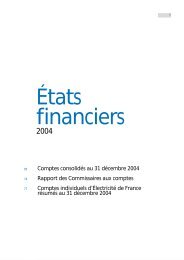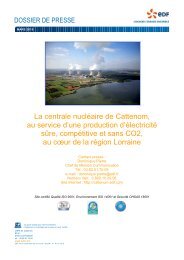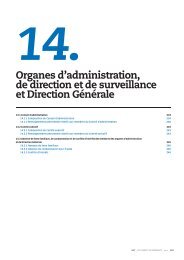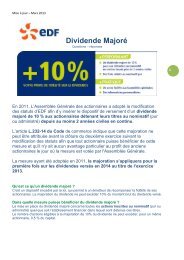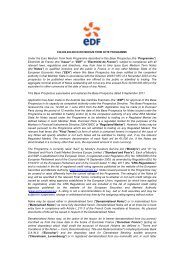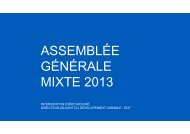EDF Energy - Finance
EDF Energy - Finance
EDF Energy - Finance
Create successful ePaper yourself
Turn your PDF publications into a flip-book with our unique Google optimized e-Paper software.
17 December<br />
<strong>EDF</strong> in the UK<br />
Investor workshop
17 December<br />
<strong>EDF</strong> in the UK<br />
Investor workshop<br />
Henri Proglio<br />
Chairman and CEO
An industrial strategy based upon <strong>EDF</strong><br />
Group core business and know-how<br />
Generation Networks Optimization/Supply<br />
• Primary focus on organic growth, supported by an important<br />
pipeline of projects<br />
• A management organization combining geographical<br />
and industrial responsibilities<br />
• Strict financial discipline
<strong>EDF</strong> Group today<br />
Nam Theun<br />
1.9 GW of nuclear<br />
capacity<br />
1.1 GW<br />
of hydro<br />
capacity<br />
3 EPR currently under construction in France (FLA3)<br />
and in China (Taishan 1&2)
<strong>EDF</strong> Group today<br />
5.6 M customers<br />
12.8 GW installed<br />
26.2 M customers<br />
96.8 GW installed<br />
1.6 M customers<br />
2.0 GW installed<br />
Central<br />
Europe<br />
540,000 customers<br />
12.3 GW installed<br />
6.3 GW installed<br />
Trading activities<br />
Nam Theun<br />
1.9 GW of nuclear<br />
capacity<br />
1.1 GW<br />
of hydro<br />
capacity<br />
3 EPR currently under construction in France (FLA3)<br />
and in China (Taishan 1&2)
Progress made on Group‟s priorities<br />
• Industrial<br />
performance<br />
• French power<br />
market reform<br />
• De-risking of the Group<br />
business profile<br />
• +14.1 TWh (+4%) as of end Nov 2010<br />
and in line with our FY target of 4 to 6%<br />
vs 2009 to 405-415 TWh<br />
• Law official on December 7 th , 2010<br />
and first decrees allowing full<br />
implementation expected during H1 2011<br />
• Comprehensive agreement with CEG,<br />
disposal of EnBW<br />
• Targeted debt reduction<br />
of at least €5Bn through<br />
disposals<br />
• Total achieved: -€13.7Bn<br />
Confirmation of 2010 financial objectives
17 December<br />
<strong>EDF</strong> in the UK<br />
Investor workshop<br />
Today's objectives and programme<br />
Thomas Piquemal<br />
Group Senior Executive Vice President<br />
<strong>Finance</strong>
Rationale for a workshop on <strong>EDF</strong> in the UK<br />
• Capital employed: €18Bn (1)<br />
• Solid upstream/downstream business model<br />
• 2009 EBITDA (2) : €2Bn<br />
• Additional value creation (life extensions, supply margins)<br />
• Potential for additional value creation through NNB<br />
• Consistent with <strong>EDF</strong> Group core skills and business<br />
• Provided all the right conditions are met, final investment<br />
decision late 2011<br />
(1) As of December 2010 estimated<br />
(2) Restated for EBITDA from UK networks, including IFRIC 18 and excluding IAS39 impact
<strong>EDF</strong> Group finance as a partner<br />
to UK business<br />
• New investment process<br />
and selection criteria<br />
• NNB: final investment decision<br />
to be taken by end 2011<br />
• Harness Group synergies<br />
and deploy Group industrial<br />
purchasing<br />
• Leverage on scale purchasing<br />
on key components<br />
• Group purchasing related<br />
to general expenses<br />
• Active Assets-Liabilities<br />
Management<br />
• Matching long-dated cashflow<br />
with long-term assets in the UK<br />
• Richer dialogue<br />
with financial community<br />
• UK workshop, including UK-only<br />
analysts
What we want to address<br />
• Well-balanced upstream/downstream business model<br />
and strategy in the UK<br />
• Challenges and opportunities of the UK power market<br />
• Value creation drivers in existing business<br />
and in new nuclear<br />
• Key financial assumptions for <strong>EDF</strong> <strong>Energy</strong>
UK workshop schedule<br />
• Welcome and introduction Henri Proglio<br />
• Today's objectives and programme Thomas Piquemal<br />
• <strong>EDF</strong> <strong>Energy</strong> compelling story Vincent de Rivaz<br />
• UK market Paul Spence<br />
• Q&A session<br />
• 10:45-11:00 Coffee break<br />
• <strong>Energy</strong> Sourcing and Customer Supply Martin Lawrence<br />
• Existing Nuclear Andy Spurr<br />
• Q&A session<br />
• 12:15-13:25 Lunch (optional sessions on ROCs and Sizewell B)<br />
• Nuclear New Build <strong>EDF</strong> Group strategy Hervé Machenaud<br />
• Nuclear New Build in the UK Humphrey Cadoux-Hudson<br />
• Q&A session<br />
• <strong>EDF</strong> <strong>Energy</strong> key financials Thomas Kusterer<br />
• Summary of key UK management priorities Vincent de Rivaz<br />
• Conclusions Thomas Piquemal<br />
• Q&A session<br />
• 15:30 End of workshop
17 December<br />
<strong>EDF</strong> in the UK<br />
Investor workshop<br />
<strong>EDF</strong> <strong>Energy</strong> compelling story<br />
Vincent de Rivaz<br />
Chief Executive, <strong>EDF</strong> <strong>Energy</strong>
Building a leader in the UK<br />
Key<br />
Financials<br />
Sales: £2.0bn<br />
EBITDA:£278m<br />
EBITDAx3.4<br />
Sales: £4.6bn<br />
EBITDA:£935m<br />
EBITDAx2.7<br />
Sales: £9.8bn<br />
EBITDA:£2.5bn<br />
1998 1999 2000 2001 2002 2003 2004 2005 2006 2007 2008 2009<br />
2010<br />
London<br />
Elecricity<br />
Sutton Bridge<br />
Power Station<br />
West Burton<br />
Power Station<br />
SEEBoard<br />
British<br />
<strong>Energy</strong><br />
SWEB Supply<br />
Business<br />
Cottam<br />
Power Station<br />
EPN<br />
Distribution<br />
Sale of<br />
Networks<br />
Scale building<br />
through acquisitions<br />
Operations<br />
integration<br />
Organic growth<br />
Upstreamdownstream<br />
integration<br />
Recent sale of our Networks business allows us to look forward
<strong>EDF</strong> <strong>Energy</strong>: from several regional brands<br />
to a strong national brand<br />
• Build a brand that customers<br />
know and find meaningful<br />
• Improve both customer retention<br />
and customer acquisition<br />
• Strategic investment to build<br />
synergy with <strong>EDF</strong> Group<br />
and to ensure competitiveness<br />
in the out of area market<br />
• 2012 Olympics and Paralympics<br />
offer unique Group opportunity<br />
• A very successful journey so far with<br />
over 90% of prompted awareness<br />
and strong environmental credentials<br />
100%<br />
90%<br />
70%<br />
50%<br />
30%<br />
22%<br />
18%<br />
14%<br />
10%<br />
6%<br />
Prompted Awareness<br />
2007 2008 2009 2010<br />
Environmentally Responsible Rating<br />
(3-month rolling avg.)<br />
2007 2008 2010
<strong>EDF</strong> <strong>Energy</strong> plays an important role<br />
in the shaping of the market reform<br />
• Leading the way in the discussion on market reform<br />
• First to assert the need of a carbon floor price<br />
• Strong supporter of market reform that takes into account<br />
the value of available capacity<br />
• The challenges of Security of Supply, Climate Change and<br />
Affordability did not exist when the market was first privatised<br />
• Need to adapt the framework to tackle these challenges<br />
• We want to help shape a better market structure<br />
• Need to build a consensus embracing the views of:<br />
• Policy makers / regulators<br />
• Investors<br />
• Customers<br />
• Local communities
<strong>EDF</strong> <strong>Energy</strong> is a key investor in the UK<br />
energy market<br />
• Investor in Generation<br />
• Fossil<br />
• Renewables<br />
• Existing and New Nuclear<br />
• Investor in Customers<br />
• B2B<br />
• B2C<br />
Two key criteria for investment<br />
• Safety<br />
• Value creation<br />
• Investor in People<br />
• Recruitment<br />
• Training
Investing in Generation<br />
Generation Asset Capacity (MW) Timeline Investment<br />
West Burton B CCGT c.1,300 2012 c.£800m<br />
Renewables >365 2011 - 2020 c.£500m<br />
AGR Life Extension c.7,500 2014 - 2023 c.£350m<br />
NNB 3,300 for first twin 2018 - 2019 c.£9Bn* for first twin<br />
• Investing in a new CCGT at West Burton that will more than offset<br />
our scheduled divestment of Sutton Bridge<br />
• Controlled and targeted Renewable Strategy<br />
• Optimisation of plant lifetime of our Existing Nuclear fleet<br />
• Potential substantial investment in Nuclear New Build<br />
* Construction costs
Investing in Customers<br />
• We are the leading electricity supplier in the UK, with over 5.5 million<br />
electricity customer accounts<br />
• Investing in information systems is a key enabler for profitability<br />
to increase along with product innovation<br />
• Our coming together with British <strong>Energy</strong> strengthens our<br />
optimisation capabilities: balancing what we produce with what we sell<br />
• We continue to work towards growing our customer base while<br />
achieving our profitability targets by 2015<br />
• B2B: over 3% EBITDA margin on sales<br />
• B2C: 5% EBITDA margin on sales
Investing in People<br />
• Of all our assets, our people are our most important investment<br />
• We must have an integrated approach within <strong>EDF</strong> Group/Existing<br />
Nuclear/ New Nuclear to building and developing our human capital<br />
• Recruit over 8,000 talented professionals by 2015<br />
• Develop leadership skills for transition to a sustainable economy<br />
• Improve employability of those in our local communities<br />
• Educate existing workforce and the wider UK public<br />
Leading the way on skills for a low-carbon economy
<strong>EDF</strong> <strong>Energy</strong>‟s organisation and leaders<br />
Chief Executive Officer<br />
Vincent de Rivaz<br />
Chief Financial Officer<br />
Thomas Kusterer<br />
Chief Officer People,<br />
Organisation & Brand<br />
Performance<br />
Philippe Huet<br />
Director of Strategy<br />
& Regulation<br />
Existing Nuclear<br />
Andy Spurr<br />
Nuclear New Build<br />
Humphrey<br />
Cadoux-Hudson<br />
<strong>Energy</strong> Sourcing<br />
and Customer Supply<br />
Martin Lawrence<br />
Paul Spence<br />
Director of Company<br />
Shared Services<br />
& Integration<br />
Peter Hofman<br />
Today’s speakers
17 December<br />
<strong>EDF</strong> in the UK<br />
Investor workshop<br />
UK market<br />
Paul Spence<br />
Director of Strategy and Regulation,<br />
<strong>EDF</strong> <strong>Energy</strong>
Price volatility<br />
Front year gas, power and carbon price<br />
£/MWh, p/th, €/tCO 2<br />
120<br />
100<br />
80<br />
60<br />
40<br />
20<br />
Rolling front year clean spreads by trade date<br />
£/MWh<br />
40<br />
30<br />
20<br />
10<br />
0<br />
Jul-06 Jul-07 Jul-08 Jul-09 Jul-10<br />
Trade date<br />
0<br />
Rolling front year power, £/MWh<br />
Rolling front year gas, p/th<br />
Front year CO 2 , €/tCO 2<br />
Jul-06 Jul-07 Jul-08 Jul-09 Jul-10<br />
Trade date<br />
Rolling front year clean dark spread<br />
Rolling front year clean spark spread<br />
Source: Spectron
Rising demand and retiring plants<br />
Capacity (GW) Capacity margin (1) (%)<br />
100<br />
40<br />
80<br />
60<br />
40<br />
20<br />
20<br />
0<br />
-20<br />
0<br />
2010 2013 2016 2019 2022 2025<br />
Capacity (includes<br />
life extension for 2 AGR)<br />
Peak demand<br />
(NG central case)<br />
-40<br />
Capacity margin<br />
(1) Wind de-rated at 10%, all other generation is not de-rated (i.e., 100% contribution)<br />
Source: <strong>EDF</strong> <strong>Energy</strong> analysis 2010
A low carbon future<br />
UK emissions, Mt CO 2 e<br />
~780<br />
Other<br />
202<br />
Opportunities<br />
• Efficiency<br />
Industry<br />
Transport<br />
168<br />
123<br />
80%<br />
reduction<br />
• Decarbonised generation<br />
• Electric heat and transport<br />
Heat<br />
79<br />
~160<br />
Electricity<br />
205 184<br />
1990 emissions 2050 target<br />
Source: DECC 2050 target, 2010 <strong>Energy</strong> Act: press clippings
Market reforms<br />
• Carbon price support<br />
• Support for low carbon generation<br />
• Contracts for difference<br />
• Premium feed-in tariff<br />
• Emission performance standard for new coal<br />
• Security guarantee (capacity mechanism)
Carbon price support<br />
Power price - Illustrative impact of carbon price support<br />
£/MWh<br />
100<br />
80<br />
60<br />
40<br />
20<br />
DECC low gas,<br />
CO 2 price scenarios<br />
Introduction £30/t £70/t<br />
0<br />
2010 2015 2020 2025 2030<br />
DECC low<br />
prices with CPF<br />
DECC medium<br />
price scenarios<br />
DECC medium<br />
prices with CPF<br />
• Description<br />
• Removing exemptions for fossil<br />
fuels in generation from Climate<br />
Change Levy<br />
• Top-up referenced against<br />
EU ETS prices<br />
• Trajectory outlined to 2030<br />
• Implications<br />
• Clear carbon price signal<br />
• Power price impact depends on<br />
underlying ETS and power prices<br />
• A balancing act:<br />
• Encouraging new low carbon<br />
investment<br />
• Maintaining flexible fossil capacity<br />
• Impact on customer bills<br />
Note: Assuming gas generation plants as price-setters<br />
Source: DECC gas price projections and carbon price projections (June 2010); <strong>EDF</strong> <strong>Energy</strong> Corporate Strategy modelling<br />
Source: HM Tresuary carbon price floor consultation
Contracts for difference<br />
Illustrative impact of contracts for difference on revenues for low<br />
carbon generators - £/MWh<br />
Introduction<br />
Generator pays<br />
difference<br />
• Description<br />
• Long term financial<br />
(not physical) contract<br />
Difference paid<br />
to generator<br />
• Referenced to wholesale power<br />
price (index to be defined)<br />
• Operational detail (and<br />
transition) to be defined<br />
• Implications<br />
• Price certainty for generator<br />
but operational and<br />
construction risks remain<br />
2010 2015 2020 2025 2030<br />
• Higher strike prices for more<br />
expensive renewables and CCS<br />
Illustrative contract strike price<br />
Power price + carbon price support<br />
Power price
… or premium feed-in tariff<br />
Illustrative impact of premium feed-in tariff on revenues for low<br />
carbon generators - £/MWh<br />
Introduction<br />
• Description<br />
• Provides extra revenue above<br />
wholesale market price for low<br />
carbon generation<br />
• Probably banded by technology<br />
• Could reward capacity (kW)<br />
or energy (kWh)<br />
• Implications<br />
• Exposure to power price<br />
uncertainty remains<br />
2010 2015 2020 2025 2030<br />
• Less impact on wholesale<br />
market operations<br />
Illustrative premium feed-in tariff<br />
Power price + carbon price support<br />
Power price
Electricity<br />
Gas<br />
Supply market growth<br />
Total domestic electricity and gas value breakdown<br />
2010 2020<br />
5%<br />
12%<br />
83%<br />
110TWh - £13.4 bn<br />
91%<br />
5%<br />
24%<br />
4% 5% 5%<br />
71%<br />
105TWh - £16.8 bn<br />
14%<br />
81%<br />
• Additional burden<br />
on energy users from<br />
climate change policies:<br />
• Supplier obligations<br />
• Smart meters<br />
• Renewable obligation<br />
• Feed-in tariffs<br />
<strong>Energy</strong>, network<br />
and other supplier costs<br />
Climate change policies<br />
VAT<br />
352TWh - £12.7 bn<br />
275TWh - £13.5 bn<br />
Source: DECC
Conclusion: an attractive market<br />
• World gas prices and low demand growth are the key<br />
determinants of the current and medium term relatively<br />
low UK energy market prices<br />
• Decreasing capacity reserve margin and impact of climate<br />
change policy on generation mix provide upward price pressure<br />
• Market reform is needed to ensure smooth transition to low<br />
carbon economy and to incentivise new generation investment
17 December<br />
<strong>EDF</strong> in the UK<br />
Investor workshop<br />
<strong>Energy</strong> Sourcing and Customer Supply<br />
Martin Lawrence<br />
Managing Director, <strong>Energy</strong> Sourcing<br />
and Customer Supply, <strong>EDF</strong> <strong>Energy</strong>
ESCS: a cornerstone of <strong>EDF</strong> <strong>Energy</strong>‟s<br />
business model<br />
Cottam<br />
power station<br />
2GW coal-fired plant<br />
West Burton<br />
power station<br />
2.1GW coal-fired plant<br />
Other sources<br />
4 x10MW gas plants<br />
365MW wind farms<br />
West Burton B<br />
power station<br />
1.3GW CCGT plant<br />
<strong>Energy</strong><br />
Sourcing<br />
Hold Separate<br />
Arrangements<br />
Sutton Bridge<br />
power station<br />
0.8GW CCGT plant<br />
Customer<br />
Supply<br />
Business to Business<br />
segment<br />
B2B (c.50TWh)<br />
Offtake agreement with<br />
Existing Nuclear fleet<br />
7GW nuclear fleet<br />
Market power<br />
purchases<br />
<strong>EDF</strong> Trading<br />
Business to Customer<br />
segment<br />
B2C (c.15TWh)<br />
Upstream: c.60 TWh/year<br />
Downstream: c.65 TWh/year
<strong>Energy</strong> sourcing<br />
A diversified portfolio of new and older<br />
generation assets<br />
• Existing portfolio includes:<br />
• Two coal plants: West Burton (2,052MW) and Cottam (2,008MW)<br />
• Combined output: 7 TWh in H1 2010 and 17 TWh in 2009<br />
• Sutton Bridge - 800 MW CCGT (ring fenced - will be divested)<br />
• Renewable portfolio (pipeline of 365 MW)<br />
• New projects include:<br />
• New CCGT West Burton (c.1,300MW), expected to be in commercial operation early 2012<br />
• Fast cycle gas storage facility in Cheshire (100m cubic meters - progressively<br />
commissioned from 2012)<br />
• Challenges facing <strong>Energy</strong> Sourcing:<br />
• Volatility of commodity prices; low dark/spark spreads<br />
• End of free carbon allocations in 2013<br />
• Develop flexible capacity to complement the company’s asset portfolio<br />
• Manage coal assets’ lives through to 2023
<strong>Energy</strong> Sourcing<br />
365MW of renewable capacity in joint-venture<br />
with <strong>EDF</strong> EN to leverage synergies<br />
• The <strong>EDF</strong> Group has 23 wind<br />
farms in the UK with capacity<br />
of 365 MW<br />
• Shared Ownership between<br />
<strong>EDF</strong> <strong>Energy</strong> (50%) and <strong>EDF</strong><br />
Energies Nouvelles (50%)<br />
• Latest Project: Teesside<br />
• Fully consented near shore<br />
project 62 MW<br />
Burnfoot Hill (26 MW)<br />
Long Park (38 MW)<br />
Great Orton II (4 MW)<br />
Fairfield (6.5 MW)<br />
Kirkheaton (1.8 MW)<br />
Green Rigg (36 MW)<br />
Broomhill (8 MW)<br />
High Hedley Hope (2.4 MW)<br />
High Hedley Hope II (5.2 MW)<br />
Langley (8 MW)<br />
Trimdon Grange (5.2 MW)<br />
Walkway (14 MW)<br />
Teesside (62 MW)<br />
Royal Oak (2.6 MW)<br />
Rusholme (24 MW)<br />
Deeping St Nicholas (12 MW)<br />
• Eligible for 2 ROCs/MWh<br />
• 50-year lease<br />
• Contracts being placed in Q3 2010<br />
and with first electrical output<br />
in Q3 2012<br />
Cemmaes (15.3 MW)<br />
Llangwyrwfon (9.3 MW)<br />
Bicker Fenn (26 MW)<br />
Red House (12 MW)<br />
Glassmor (16 MW)<br />
Redtile (24 MW)<br />
Cold Northcott (6.6 MW)<br />
In operation<br />
In construction<br />
Consented
Customer Supply<br />
<strong>EDF</strong> <strong>Energy</strong> is the UK‟s leading<br />
B2B business<br />
• UK B2B market is c.190 TWh<br />
7 major suppliers<br />
GDF Suez <strong>Energy</strong><br />
5%<br />
Others<br />
7%<br />
Scottish Power<br />
5%<br />
<strong>EDF</strong> <strong>Energy</strong><br />
26%<br />
British Gas<br />
10%<br />
E.ON<br />
14%<br />
RWE npower<br />
17%<br />
• <strong>EDF</strong> <strong>Energy</strong> is the largest supplier of B2B electricity<br />
(c.300,000 customers)<br />
• Merged with British <strong>Energy</strong> B2B business (British <strong>Energy</strong> Direct)<br />
• c.50 TWh of electricity representing 26% market share<br />
• 2009 key financials: £3.8bn sales and EBITDA of c.£160m<br />
Scottish & Southern <strong>Energy</strong><br />
16%
Customer Supply<br />
B2B strategy focused on customer service<br />
and risk management<br />
• Limit volatility of earnings and deliver at least 3% EBITDA<br />
margin on sales<br />
• Top line growth to be delivered through development<br />
of customised energy services<br />
• Areas of focus:<br />
• Secure margin<br />
• Improved contract management<br />
• Customised hedging<br />
• New systems development to deliver cost savings<br />
and improved services
Customer Supply<br />
B2C is a very competitive market with further<br />
growth opportunities for <strong>EDF</strong> <strong>Energy</strong><br />
• UK B2C market is c.120 TWh electricity and c.335 TWh gas - 6 Major Suppliers<br />
21%<br />
20%<br />
19%<br />
18%<br />
B2C Market Churn (Gas & Elec)<br />
% Total Accounts<br />
30-Apr-10 (outer) vs 30-Apr-09 (inner)<br />
<strong>EDF</strong><br />
10.7<br />
SP<br />
9.8<br />
10.3<br />
10.7 31.7<br />
32.9<br />
BG<br />
17%<br />
16%<br />
NP<br />
13.0<br />
13.7<br />
15.4<br />
18.0<br />
15%<br />
2005 2006 2007 2008 2009 2010F<br />
EON<br />
15.1<br />
18.1<br />
SSE<br />
(source: DECC)<br />
(source: CEA)<br />
• The <strong>EDF</strong> <strong>Energy</strong> B2C business is the 5th largest in the UK<br />
(5.1m product accounts)<br />
• In 2009 the B2C business supplied 15 TWh of electricity representing 12% market share<br />
and 26 TWh of gas representing 8% market share<br />
• For the year ended 31 December 2009, B2C recorded an EBITDA loss of £167m
Customer Supply<br />
Three main levers to reach 5% EBITDA<br />
margin on sales by 2015<br />
• Investment of c.£150m in new<br />
Customer and Billing System<br />
• Reduced Cost to Serve<br />
• Improved Customer service<br />
• Started 2009 - Full implementation 2011<br />
Price &<br />
Product<br />
optimisation<br />
Smart<br />
metering<br />
benefits<br />
• Target to grow from 5.1m to 6.1m<br />
product accounts by 2015<br />
• Targeted customer growth (high value/<br />
low risk) to achieve economies of scale<br />
• Develop innovative energy products<br />
and non-energy products<br />
• Leverage smart metering<br />
opportunities<br />
2009<br />
EBITDA<br />
Cost to Serve<br />
improvements<br />
Growth of<br />
profitable<br />
customers<br />
Improved<br />
Billing &<br />
Settlements<br />
<strong>Energy</strong><br />
services<br />
activity<br />
Bad debt<br />
management<br />
2015<br />
Target
Customer Supply<br />
Focus on smart metering opportunity<br />
• In order to support carbon reduction target, the UK government has mandated<br />
smart metering roll-out by 2020 at the latest<br />
Proposed Smart meter roll-out timeline<br />
2011 2012 2013 2018 2019 2020<br />
Summer 2012<br />
Mandated Smart<br />
meter roll-out starts<br />
Autumn 2013<br />
Data Communications<br />
Company (DCC) goes live<br />
2018<br />
Potential completion target<br />
based on Charles Hendry<br />
statements<br />
End 2020<br />
Expected roll-out<br />
completion date<br />
Preparation for roll-out Mandated roll-out phase Go-live (full roll-out with DCC in place)<br />
• Currently developing business case around key value enhancing<br />
opportunities:<br />
• Reduced metering and rental costs<br />
• Reduced bad debt charge<br />
• Improved hedging and volume forecasting capabilities<br />
• <strong>Energy</strong> related services cross selling opportunities<br />
• Increased customer satisfaction<br />
• Any net costs are expected to be passed-through in tariff
ESCS - Optimisation<br />
Integrated generation and supply management<br />
One common goal: to maximise the energy gross margin<br />
(generation + supply)<br />
Generator Optimiser Supplier<br />
Key objectives<br />
Operate, maintain and<br />
develop the fleet of<br />
generation assets<br />
Key objectives<br />
Design the overall portfolio<br />
Optimise the portfolio<br />
Manage risk<br />
Key objectives<br />
Management<br />
and development<br />
of customer portfolio<br />
Drivers<br />
Availability of fleet<br />
Drivers<br />
Wholesale market<br />
Structured contracts<br />
Peak management<br />
Drivers<br />
Sales price/margins<br />
Market share
Our hedging strategy is asset driven but takes into account<br />
both market specificities and competitors expectations<br />
Market Drivers<br />
Prices<br />
Volatilities<br />
Correlation<br />
Liquidity<br />
Portfolio Drivers<br />
Open Positions<br />
Generation Uncertainty<br />
Demand Uncertainty<br />
Tariff Drivers<br />
Competitors’ EBIT<br />
Competitors’ Retail Margin<br />
Competitors’ Hedging Rate<br />
Nuclear and<br />
Upstream<br />
B2C<br />
• Gradually reduce<br />
width of risk<br />
distribution for Nuclear<br />
and Upstream<br />
• Hedging rate changes<br />
in response to market<br />
and portfolio drivers<br />
• Gradually reduce<br />
width of risk<br />
distribution for B2C<br />
• Hedging rate changes<br />
in response to market,<br />
portfolio and tariff<br />
drivers
Key conclusions<br />
• ESCS manages existing assets to extract maximum value whilst<br />
investing to address risks from exposure to such factors as market shape,<br />
volatility, ROCs, etc.<br />
• In the electricity B2B market, <strong>EDF</strong> <strong>Energy</strong> aims to remain the market<br />
leader, consistently delivering +3% EBITDA margin on sales in 2015<br />
• In the B2C market, <strong>EDF</strong> <strong>Energy</strong> wants to achieve a steady volume growth<br />
while progressively reaching 5% EBITDA margin on sales in 2015<br />
• <strong>EDF</strong> <strong>Energy</strong> seeks dynamically to review its optimisation/hedging<br />
strategy in line with market movements
17 December<br />
<strong>EDF</strong> in the UK<br />
Investor workshop<br />
Existing Nuclear<br />
Andy Spurr<br />
Managing Director, Existing Nuclear,<br />
<strong>EDF</strong> <strong>Energy</strong>
Key topics<br />
•Update on 2010 performance<br />
•Medium term ambitions and expected performance<br />
•Plant life extension strategy
2010: a challenging year with<br />
a good underlying AGR performance<br />
• 2009 - a successful year in terms of nuclear output with output<br />
at 55.1TWh being 1.5TWh better than plan<br />
• 2010 - a more challenging year in terms of nuclear output<br />
• Significant losses have come from a handful of large loss events:<br />
• Sizewell B Pressuriser c.6TWh<br />
• Heysham 2 ISI Plug c.3TWh<br />
• Dungeness B R21 Header Inspections c.3TWh<br />
• Underlying AGR fleet output comparable to 2009 and better<br />
than recent years<br />
• Safety performance remains very strong and improving<br />
• Heysham 1 and Hartlepool additional 5-year life extension<br />
now announced
TWh<br />
2010 AGR output is comparable to 2009<br />
60<br />
AGR Output (TWh)<br />
50<br />
40<br />
*<br />
30<br />
20<br />
10<br />
0<br />
2006 2007 2008 2009 2010F<br />
Calendar Year<br />
* 2006 has been normalised for Hinkley Point B and Hunterston B boiler restrictions
Sizewell pressuriser - a unique issue<br />
successfully resolved<br />
• Defects relate to Pressuriser heater<br />
well inserts<br />
• There are 78 heater well inserts which<br />
allow insertion of heater elements into<br />
the pressuriser<br />
• The heater well inserts are the<br />
Westinghouse Type 3 design manufactured<br />
from a single piece stainless steel forging<br />
and are of unique design<br />
• During the next outage in 2011 these<br />
heaters are expected to be replaced<br />
with a problem free design<br />
• We do not therefore expect further<br />
losses due to this issue<br />
2000-2009 Sizewell B output<br />
TWh<br />
High 10.3<br />
Average 9.1<br />
Low 8.5
Lostime accidents per 20,000 hours worked<br />
Survey Score<br />
Safety indicators have improved<br />
significantly<br />
1.00<br />
Accident frequency rate<br />
0.75<br />
EN Station Employees<br />
EN Station Contractors<br />
Comparison<br />
value<br />
Good<br />
0.50<br />
0.25<br />
<strong>EDF</strong> 0.38<br />
<strong>EDF</strong> <strong>Energy</strong><br />
UK 0.30<br />
0<br />
2001/02 08-05 11-06 02-08 05-09 08-10<br />
WANO<br />
Median-<br />
Employees<br />
0.03 (Jan 10)<br />
Nuclear Reportable Events<br />
Staff Nuclear Safety Culture Survey Score<br />
80<br />
60<br />
40<br />
20<br />
0<br />
65<br />
77<br />
47<br />
36<br />
22<br />
4<br />
7<br />
5<br />
7<br />
Good<br />
3.7<br />
3.6<br />
3.5<br />
3.4<br />
2005 2007 2010<br />
Good<br />
Year of Survey
UATR (Trips per 7000 hrs critical)<br />
Index (Range 0-100)<br />
Apr-07<br />
Apr-97<br />
Jul-07<br />
Apr-98<br />
Oct-07<br />
Apr-99<br />
Jan-08<br />
Apr-00<br />
Apr-08<br />
Apr-01<br />
Jul-08<br />
Apr-02<br />
Oct-08<br />
Apr-03<br />
Jan-09<br />
Apr-04<br />
Apr-09<br />
Apr-05<br />
Jul-09<br />
Apr-06<br />
Oct-09<br />
Apr-07<br />
Jan-10<br />
Apr-08<br />
Apr-10<br />
Apr-09<br />
Jul-10<br />
Oct-10<br />
Apr-10<br />
Days<br />
Mar-03<br />
Apr-09<br />
Jun-09<br />
Mar-04<br />
Aug-09<br />
Mar-05<br />
Oct-09<br />
Dec-09<br />
Mar-06<br />
Feb-10<br />
Mar-07<br />
Apr-10<br />
Jun-10<br />
Mar-08<br />
Aug-10<br />
Mar-09<br />
Oct-10<br />
Dec-10<br />
Mar-10<br />
Underlying nuclear output indicators<br />
continue to improve<br />
3.50<br />
3.00<br />
Fleet 12-month UATR<br />
200<br />
Post Outage Return to Service Run<br />
(10 Outage Running Average)<br />
2.50<br />
2.00<br />
1.50<br />
1.00<br />
Good<br />
100<br />
Good<br />
0.50<br />
0.00<br />
Date<br />
0<br />
Equipment Reliability Index<br />
Preventative maintenance backlog<br />
14000<br />
55<br />
45<br />
Good<br />
12000<br />
10000<br />
8000<br />
6000<br />
Good<br />
35<br />
4000<br />
2000<br />
25<br />
0
Existing Nuclear has a clear plan to<br />
maximise performance and long term value<br />
Performance<br />
Objectives<br />
• Existing Nuclear’s key objectives<br />
• Improve operational excellence<br />
• Maintain adequate nuclear investment<br />
(around £300m in 2010)<br />
• Train and prepare people to support new build program<br />
• Deliver integration synergies<br />
• Consistently achieve nuclear output above 55TWh<br />
Strategic target<br />
• Main strategic aim: secure plant life extension<br />
• Extend the lives of our AGR fleet by an average<br />
of five years and Sizewell B by 20 years<br />
• Further life extensions could help avoid c.4GW<br />
of new fossil generation required in the UK before 2018<br />
• It may also provide flexibility in the crucial objective<br />
of retaining skilled operational workforce
Three strategic levers for delivering<br />
our ambitions<br />
• PEOPLE - Nuclear professionals doing the right things<br />
• Sufficiently qualified/experienced staff to support Existing Nuclear and NNB<br />
• Strong leaders driving the business<br />
• Building sustainability and diversity<br />
• PLANT - Safe and reliable plant<br />
• Optimise deployment of engineering services<br />
• Drive efficiency improvements<br />
• PROCESS - Fit for purpose systems and processes<br />
• Examine core processes, ensure internal control, monitor risks<br />
• Deliver synergies
Nuclear output target for future years<br />
• Focusing on People, Plant and Process is delivering results<br />
• Future investment will continue at around £300m per annum<br />
• The objective is to eliminate small losses and prevent large losses<br />
• Delivery of further life extensions is expected<br />
We are targeting nuclear output<br />
of more than 55TWh in future years
On track to deliver integration synergies<br />
• Total synergies announced at the time of the British <strong>Energy</strong> acquisition,<br />
€200m over three years to 2011<br />
• We expect to have delivered across <strong>EDF</strong> <strong>Energy</strong> over £150m (c.€180m)<br />
by year end<br />
• Synergies specifically within Existing Nuclear are being delivered<br />
in the following areas:<br />
• Lower nuclear insurance costs<br />
• Nuclear fuel synergy from bringing together favourable contractual positions of British <strong>Energy</strong><br />
and <strong>EDF</strong> Group<br />
• <strong>EDF</strong> Group technical input into the resolution of the Hot Box Dome issue<br />
at Heysham 1 and Hartlepool<br />
• IT synergies<br />
• Costs avoidance (e.g. engineer recruitment costs, training centre set up costs, cash collateral costs,…)<br />
• Other areas of synergies: outage management, training and Human<br />
Performance, engineering<br />
We are on track to deliver and even exceed<br />
acquisition synergy targets
Aim to achieve 5-year extension for AGR<br />
on average<br />
Power Station<br />
Start<br />
of Generation<br />
Scheduled<br />
Closure Date<br />
Accounting<br />
Lifetime<br />
Scheduled<br />
Periodic Safety<br />
Review<br />
Hinkley Point B Feb 1976 2016 40 years 2017<br />
Hunterston B Feb 1976 2016 40 years 2017<br />
Dungeness B Apr 1983 2018 35 years 2018<br />
Heysham 1 Jul 1983 2014 2019 30 years 35 years 2019<br />
Hartlepool Aug 1983 2014 2019 30 years 35 years 2019<br />
Torness May 1988 2023 35 years 2020<br />
Heysham 2 Jul 1988 2023 35 years 2020<br />
Sizewell B Feb 1995 2035 40 years 2015<br />
• Consistent with British <strong>Energy</strong> acquisition target<br />
• Life extension will require minimal incremental capex<br />
(c.£50m per plant (c.£25m/reactor) on average)<br />
• 20-year extension will be targeted for Sizewell B
Key conclusions<br />
• 2010 has been a challenging year but mostly because<br />
of a one-off issue at Sizewell B. Allowing for that impact,<br />
2010 would be as good a year as 2009<br />
• Existing Nuclear have clear ambitions and a plan<br />
to consistently achieve a nuclear output above 55TWh<br />
• Existing Nuclear is on track to deliver an average<br />
of five year Plant Life Extension across the AGR fleet
17 December<br />
<strong>EDF</strong> in the UK<br />
Investor workshop<br />
Nuclear New Build <strong>EDF</strong> Group strategy<br />
Hervé Machenaud<br />
Group Executive Vice President<br />
Generation and Engineering<br />
and Asia Pacific President
GW<br />
11 10 10 7 6 6 5 5 5 4 4 4 4 4 3<br />
<strong>EDF</strong>‟s leader position in nuclear generation<br />
74 (*)<br />
This is the reason why <strong>EDF</strong><br />
is a valued partner worldwide<br />
23<br />
18 17 16<br />
Source: companies’ internet websites - <strong>EDF</strong>’s 2009 Document de Référence<br />
(* )<strong>EDF</strong> SA and affiliates (pro-rata values), restated for EnBW
<strong>EDF</strong>‟s strategy in nuclear<br />
• <strong>EDF</strong>’s strategy is :<br />
to leverage operational experience from the French fleet<br />
(more than 1,400 years-reactors)<br />
and to benefit from the feedback from the construction/operation<br />
of new nuclear power plants (NPPs) worldwide<br />
• <strong>EDF</strong> wishes to accompany countries/players who are launching<br />
new civil nuclear power programmes, acting as an architect/engineer,<br />
and also as an investor in targeted countries<br />
<strong>EDF</strong> strongly believes:<br />
• One’s ability to efficiently operate a nuclear plant is enhanced<br />
when one has actually built it<br />
• Building a new nuclear plant is easier if one has already operated one
<strong>EDF</strong>‟s business model in nuclear<br />
• Project Management (schedule, cost, quality, interface<br />
management, risk analysis…)<br />
• Licensing process<br />
• Definition of general technical codes and specifications<br />
• Definition of contract allotment, contract specification<br />
technical contract management<br />
• Manufacturing surveillance<br />
• Construction on site and commissioning test management<br />
• Optimisation between construction and future operation
Conditions precedent for <strong>EDF</strong> to accompany<br />
a country wishing to launch a new nuclear programme<br />
• Positive government support and public acceptance<br />
• Stable and transparent regulatory framework<br />
• Available local partners<br />
• Availability of sites<br />
• Manageable market risk and profitability prospects<br />
• Suitable grid connection conditions<br />
• Available local industry and human resource skills
<strong>EDF</strong>‟s nuclear projects<br />
France<br />
Flamanville 3<br />
2014<br />
France<br />
Penly 3<br />
Under construction<br />
Under development<br />
China<br />
2 EPR in Taishan with CGNPC<br />
1 st unit in 2014<br />
United Kingdom<br />
Up to 4 EPR (Hinkley Point & Sizewell)<br />
USA<br />
Calvert<br />
Cliffs 3<br />
Under "pre-development"<br />
Italy<br />
Development agreement with ENEL<br />
for the construction of 4 EPR<br />
Netherlands<br />
Feasibility study<br />
agreement with Delta<br />
Poland<br />
Feasibility study<br />
agreement with PGE
France : Flamanville 3<br />
The first EPR reactor of a series of several projects<br />
• Start of marketable operations targeted for 2014<br />
• Construction costs c.€ 5 billion<br />
• Significant progress made<br />
in the construction<br />
• Discharge tunnel completed<br />
• Issues related to steel<br />
rebars and liner solved<br />
• Last step of Main Civil Works<br />
in progress<br />
• Beginning of electromechanical<br />
assembly
Flamanville EPR milestones<br />
2006 2007 2008 2009 2010 2011 2012 2013 2014<br />
Preparatory<br />
works<br />
Authorization<br />
decree<br />
Reactor building<br />
first concrete<br />
Civil works<br />
Reactor building<br />
dome implementation<br />
Electromechanical works<br />
Vessel introduction<br />
in the reactor building<br />
Test and commissioning<br />
Fuel loading<br />
Grid<br />
connection
China : Taishan 1 & 2<br />
• <strong>EDF</strong> is co-investor/operator with CGNPC for 2 EPR in Taishan<br />
• The Taishan project uses Flamanville 3 as a reference model<br />
after taking into account the initial feedback<br />
Concrete pouring methods and liner welding procedures took advantage<br />
from Flamanville’s feedback<br />
• The Taishan project<br />
is on time:<br />
• First concrete poured in October<br />
2009 for unit 1 and April 2010<br />
for unit 2<br />
• Lifting of the module 1 of the liner<br />
of the reactor building<br />
of unit 1 in March 2010<br />
• Commissioning date<br />
expected in 2014 Taishan 1 : Liner module 1 lifting March 2010
A positive series effect<br />
• Building twin units on a same site results in savings<br />
• Cost sharing of all the licensing and the "First Of A Kind" engineering<br />
• Learning curve effect on design, procurement and construction<br />
• Common site works and buildings (including land preparatory works)<br />
• Sharing of equipment and services for operations<br />
• Launching a programme of several standardized units<br />
in the same country enables additional cost reductions<br />
• Enhanced use of learning curve<br />
• Development and optimisation of industrial capacities (procurement<br />
and supply of the equipment)<br />
• Further economies of scale on operational, maintenance<br />
and spare parts resources
EPR: a series of several projects that will<br />
benefit from the feedback from one project<br />
to another<br />
Flamanville 3 Flamanville 3<br />
Penly 3<br />
Hinkley<br />
Point 2<br />
4.5<br />
months<br />
Taishan<br />
1<br />
months<br />
47<br />
weeks<br />
Taishan<br />
10<br />
weeks<br />
Hinkley<br />
Point 1<br />
Concrete<br />
pouring<br />
Fixing<br />
of containment<br />
liner<br />
Taishan 2<br />
• Reactor base done in one<br />
pour to improve efficiency<br />
Taishan 1<br />
• Civil works feedback to optimise<br />
construction methods<br />
Flamanville<br />
3<br />
• Issue with liner containment building<br />
• Prefabrication of dome and liner leading<br />
to efficient welding to improve quality<br />
and time
Several reactors and business models<br />
• Reactors<br />
• EPR, using Flamanville 3 and Taishan feedback as well as further optimization<br />
An international workshop “EPR Family” has been set up to share construction<br />
feedback and operating preparation<br />
• Other PWR reactors to be developed to meet diverse requirements<br />
in the world, including a 1,000 MW reactor<br />
• Business model example<br />
Financial<br />
commitment<br />
Holding<br />
Industrial<br />
commitment<br />
« GENCO »<br />
Construction<br />
Operations
A key issue for the success of nuclear<br />
projects: global HR management<br />
• More than 1,000 people within <strong>EDF</strong><br />
Nuclear Engineering Division dedicated<br />
to EPR activities for France, UK, China<br />
and other new build projects (30 French<br />
engineers in the UK, 43 in China)<br />
• Cooperation on nuclear staffing, specially<br />
between France and the UK for workforce<br />
plans, recruitments and training<br />
• Exchanges of people between countries<br />
• Common EPR training programs<br />
• More than 2000<br />
recruitments per year<br />
in 2010-2013 to anticipate<br />
skills needs in nuclear<br />
area<br />
• Promotion of nuclear jobs<br />
towards young people<br />
• Development of<br />
partnerships with<br />
universities in France,<br />
the UK, the USA, Italy<br />
• Nuclear Power Academies<br />
in France and the UK
UK: a strong strategic fit for <strong>EDF</strong><br />
new nuclear strategy<br />
• Strong commitment to Nuclear New Build in the UK demonstrated<br />
by the Government<br />
• Leverage of <strong>EDF</strong> <strong>Energy</strong>’s presence in the UK as well as sites<br />
and expertise following British <strong>Energy</strong>’s acquisition<br />
• Significant progress with Generic Design Assessment<br />
of EPR technology that will enable UK EPR plants<br />
to be built as part of a fleet of EPR reactors
17 December<br />
<strong>EDF</strong> in the UK<br />
Investor workshop<br />
UK Nuclear New Build<br />
Humphrey Cadoux-Hudson<br />
Managing Director, Nuclear New Build,<br />
<strong>EDF</strong> <strong>Energy</strong>
New Nuclear is needed to address all three<br />
main energy challenges in the UK<br />
• Security of supply: Nuclear New Build (NNB) provides<br />
reliable baseload generation<br />
• Climate change:<br />
• Affordability:<br />
NNB is mostly carbon free<br />
NNB is the lowest cost proven<br />
low carbon technology<br />
UK Government is setting a strong framework<br />
for new investment in the UK
New nuclear is the lowest-cost low-carbon<br />
technology<br />
Range of Levelised Costs of Production (£/MWh) in 2009 real terms<br />
Projects starting from 2017 and 2023 - „Nth of a Kind‟<br />
120<br />
51-113<br />
68-124<br />
93-118<br />
108-128<br />
• Source: independent study<br />
commissioned by DECC<br />
100<br />
80<br />
71-86<br />
53-69<br />
• Nuclear is projected to be<br />
the lowest-cost low-carbon<br />
technology<br />
60<br />
40<br />
20<br />
• Under a low commodity price/<br />
low carbon price, CCGT is likely<br />
to be the most competitive<br />
technology<br />
0<br />
CCGT<br />
CCGT<br />
CCS<br />
Coal<br />
CCS<br />
Onshore<br />
Offshore<br />
Nuclear<br />
• Build-out of CCGT will lead to<br />
missing decarbonisation targets<br />
Source: DECC (based on Mott Macdonald Report – June 2010)<br />
Note: These ranges include costs of projects with start dates of 2017 and 2023 with a discount factor of 7.5% or 10%;<br />
includes both low and high commodity price scenarios from DECC<br />
Coal with CCS includes pulverised coal plant with post combustion only<br />
Offshore wind includes Round 3 projects only
We aim to build up to four nuclear<br />
power stations in the UK<br />
• Our plan: up to four nuclear power stations subject<br />
to receiving the necessary consents and to a robust<br />
investment framework being in place<br />
• Targeted locations:<br />
• Twin at Hinkley Point (first unit commissioned by 2018)<br />
• Twin at Sizewell (subject to ongoing studies)<br />
• Build on <strong>EDF</strong> Group's fleet effect and feedback: Flamanville 3<br />
and Taishan 1&2<br />
• Centrica 20% partner with a potential for further partnership
MARKET REFORM<br />
Consenting<br />
Licensing<br />
Design<br />
Procurement<br />
Manufacturing<br />
Construction<br />
Commissioning<br />
Operations<br />
Decommissioning<br />
Our project organisation is up and running<br />
NNB Owner/Operator<br />
• Organisation up and<br />
running and working<br />
as one team<br />
• <strong>EDF</strong> <strong>Energy</strong> and the<br />
Architect Engineer (1)<br />
working to incorporate<br />
lessons learnt from<br />
earlier EPR projects<br />
• Clear responsibility<br />
and accountability<br />
NNB Design and Quality Assurance<br />
(1) <strong>EDF</strong> French Engineering Division<br />
Architect Engineer<br />
(<strong>EDF</strong> French Engineering<br />
Division)<br />
NNB<br />
(<strong>EDF</strong> <strong>Energy</strong> Owner<br />
/ Operator)<br />
Architect Engineer /<br />
NNB Shared<br />
Key Interface
Setting up the ground work<br />
for a successful project<br />
• Creating a strong relationship with Nuclear Installations<br />
Inspectorate (NII)<br />
• NII GDA (Generic Design Assesment) team and process established<br />
• Draft Nuclear Site Licence (NSL) submitted in April 2010 to NII<br />
• Preparing development at Hinkley Point<br />
• Stage 1 and 2 consultation process completed<br />
• Assessing Sizewell<br />
• Testing the site and confirming potential development
Significant progress has been made with<br />
Government, regulators and suppliers<br />
• Government Policy<br />
• Draft National Policy Statement (NPS) includes new nuclear requirement<br />
• Carbon floor price and market reform on agenda<br />
• Generic Design Assessment (GDA)<br />
• Report issued to Health and Safety Executive (HSE) in October 2009<br />
(Step 3 of 4 in process)<br />
• Resolution on Instrumentation and Control (I&C) design<br />
• Regulators believe all known issues can be resolved (August 2010)<br />
• Supply Chain<br />
• High profile supply chain events held through 2010<br />
• Site works, grid connections and reservation of forgings commenced
Key Risk Milestones to be met before Final<br />
Investment Decision: traffic lights (1/2)<br />
Autumn 2010<br />
Winter 2010 /<br />
2011<br />
Spring 2011 Summer 2011 Autumn 2011<br />
Winter 2011 /<br />
2012<br />
Carbon<br />
Price<br />
Floor<br />
Consultation<br />
Review<br />
2011 Budget<br />
& <strong>Finance</strong> Bill<br />
“Parliamentary Pathway”<br />
<strong>Energy</strong><br />
National<br />
Policy<br />
Statements<br />
Consultation<br />
Parliamentary<br />
Review<br />
Debate, vote and ratification<br />
Market<br />
Reform<br />
Consultation<br />
Drafting of <strong>Energy</strong><br />
White Paper<br />
Publication of <strong>Energy</strong><br />
White Paper<br />
SQSS<br />
In feed loss<br />
Change<br />
SQSS<br />
Frequency<br />
Response<br />
Charges<br />
Ofgem‟s Impact<br />
Assessment on SQSS<br />
Ofgem Decision on<br />
SQSS limits<br />
Call for Evidence: TCR<br />
Significant Code Review<br />
Ofgem Decision<br />
on charging<br />
Funded<br />
Decommissioning<br />
Plan<br />
Revised<br />
Consultation<br />
<strong>Energy</strong> Act (EA) Amendments<br />
and Bill publication<br />
FDP and Waste Contracts<br />
Submission<br />
Secretary of State<br />
Endorsement<br />
EA Legislation Passed<br />
SQSS: Security and Quality of Supply Standard<br />
Note: December 17th 2010 is denoted by
Key Risk Milestones to be met before Final<br />
Investment Decision: traffic lights (2/2)<br />
Autumn<br />
2010<br />
Winter 2010<br />
/ 2011<br />
Spring 2011<br />
Summer<br />
2011<br />
Autumn<br />
2011<br />
Winter 2011<br />
/ 2012<br />
Spring 2012<br />
Summer<br />
2012<br />
IPC<br />
Consent<br />
Development Consent Order<br />
Application to IPC<br />
IPC Consent<br />
Granted<br />
Site<br />
Excavation<br />
Planning<br />
Permission<br />
Received<br />
Planning Permission<br />
Granted<br />
Nuclear<br />
Site<br />
Licence<br />
Granted<br />
Formal Nuclear Site<br />
Licence Submission<br />
Nuclear Site Licence Granted<br />
GDA-DAC<br />
NII approves Long Lead<br />
Item Procurement<br />
Interim Design Acceptance<br />
Confirmation Issued<br />
Final Design Acceptance<br />
Confirmation Issued<br />
IPC : Infrastructure and Planning Commission<br />
GDA-DAC: Generic Design Assesment<br />
Note: December 17th 2010 is denoted by
Hinkley Point EPR Unit 1 Milestones<br />
2010 2011 2012 2013 2014 2015 2016 2017 2018<br />
Site Preparations<br />
Excavation<br />
Reactor building<br />
first concrete<br />
Civil works<br />
Reactor building<br />
dome implementation<br />
Electromechanical works<br />
Vessel introduction<br />
in the reactor building<br />
Test and commissioning<br />
Fuel loading<br />
Grid<br />
Connection
Key Assumptions which will form part<br />
of our Investment Case<br />
• Operational:<br />
• Operational start - EPR 1, 2018; EPR 2, 18 months after<br />
• Operating Life - 60 years<br />
• Construction:<br />
• Based on Flamanville 3 design, updated for UK specifications<br />
• Reflects UK tendered contracts (e.g. Nuclear Steam Supply System<br />
and turbine generator)<br />
• O&M:<br />
• Based on experience of French fleet, updated for UK specifications<br />
• Include fuel, ongoing O&M, transmission costs, insurance and business rates<br />
• Waste and Decommissioning:<br />
• Based on Funded Decommissioning Plan being negotiated with UK Government
Series effect significantly brings down construction<br />
costs for the first twin at Hinkley Point<br />
£ in 2010 real<br />
Total (twin)<br />
Costs<br />
(based on FLA3 adjusted for UK)<br />
Construction costs for a twin<br />
Total costs to final investment decision<br />
c.£9bn<br />
£1bn<br />
Benefit of Series Effect for Construction Cost<br />
EPR 1 to EPR 1 & 2 15%
Market reform impact is a positive step<br />
towards a final investment decision<br />
• Carbon price floor would limit revenue risk in low commodity<br />
price scenarios<br />
• Capacity payment would set an absolute profitability floor<br />
protecting the recovery of sunk costs<br />
• De-risking of the investment decision<br />
Targeted minimum IRR > 10%
Summary<br />
• UK needs NNB in order to tackle its three energy challenges<br />
• There is strong social and political support for NNB<br />
• <strong>EDF</strong> <strong>Energy</strong> is ahead of the game with its NNB programme<br />
and on track for commissioning of the first power station in 2018<br />
• Market reform is a first positive step towards securing<br />
a minimum IRR<br />
• <strong>EDF</strong> <strong>Energy</strong> has developed a traffic light approach<br />
to control risk exposure associated with this project
17 December<br />
<strong>EDF</strong> in the UK<br />
Investor workshop<br />
<strong>EDF</strong> <strong>Energy</strong> key financials<br />
Thomas Kusterer<br />
Chief Financial Officer, <strong>EDF</strong> <strong>Energy</strong>
EBITDA (£m)<br />
<strong>EDF</strong> <strong>Energy</strong>‟s EBITDA structure<br />
and key performance drivers<br />
Key medium term drivers<br />
2,500<br />
2,000<br />
ESCS<br />
Level of Clean Dark Spread<br />
B2C margin and volume<br />
B2B margin and volume<br />
New Investment commissioning<br />
1,500<br />
Existing<br />
Nuclear<br />
Wholesale market price<br />
Total output<br />
Life extension achievement<br />
1,000<br />
500<br />
0<br />
For balance of year<br />
post completion<br />
Networks<br />
Others<br />
2010 Forecast (1)<br />
c.£760m of divested EBITDA<br />
£5.8bn reduction in Net Debt<br />
Fair value accounting impact<br />
Support function cost control<br />
(1) Based on 12-month ownership of the Networks
Networks sale<br />
• On 29 October 2010, <strong>EDF</strong> <strong>Energy</strong> completed the sale<br />
of its Distribution business to Cheung Kong Infrastructure (CKI)<br />
• Sale proceeds: £5.8bn (including debt of £2.6bn)<br />
• The proceeds represent a 27% premium to RAV (1)<br />
and an IRR of 11.2% since acquisition<br />
• Post sale, <strong>EDF</strong> <strong>Energy</strong> will not be impacted by IFRIC 18<br />
accounting as this was solely related to Customer Connections<br />
within Regulated Networks<br />
(1) Based on official RAV on regulated networks as at 31/03/2010
Summary of main investment plans*<br />
• Business as usual capital expenditure includes:<br />
• ESCS c.£150m p.a. fossil plant maintenance and supply IT systems<br />
• Existing Nuclear c.£300m p.a. nuclear plant maintenance<br />
• Shared Service Centre c.£20m p.a. support to various IT projects<br />
• <strong>EDF</strong> <strong>Energy</strong> also expects to spend £50m per plant for AGR plant life extension<br />
• In addition, <strong>EDF</strong> <strong>Energy</strong> will continue to invest c.£600m in a wide range<br />
of other Strategic Projects over the next 5 years<br />
New Projects* 2010 2011-2015<br />
West Burton B (new CCGT) £260m £190m<br />
Renewables £35m £215m<br />
Gas Storage £50m £130m<br />
Customer Relationship Management - B2C £40m £15m<br />
Customer Relationship Management - B2B £6m £40m<br />
Total £391m £590m<br />
*Excludes smart metering and Nuclear New Build
British <strong>Energy</strong> value in use is greater<br />
than book value<br />
£5.2bn<br />
Goodwill<br />
£7.2bn<br />
Net assets<br />
purchased<br />
• Synergy delivery on track with acquisition<br />
business case<br />
• Life extension assumptions confirmed as a<br />
result of today’s announcement on Heysham<br />
and Hartlepool<br />
• Plan for up to four new nuclear power<br />
stations in the UK currently being developed<br />
in partnership with Centrica<br />
• 2009 output above assumed business plan<br />
• 2010 impacted by a one off PWR issue;<br />
AGRs output in line with business plan<br />
• Slight downward trend in wholesale prices
Fair value accounting<br />
• The fair value adjustments arising on the acquisition<br />
of British <strong>Energy</strong> are broadly broken down into 2 key areas:<br />
• Unwind of nuclear fuel stock fair value uplift and the fuel contract asset<br />
• Provision for the mark to market of trading contracts<br />
• A forecast of fair value adjustments to EBITDA<br />
for the next five years is as follows:<br />
2010F 2011F 2012F 2013F 2014F<br />
EBITDA FV<br />
Adjustments (£m)<br />
267 150 (71) (76) (54)
Key conclusions<br />
• Underlying <strong>EDF</strong> <strong>Energy</strong> EBITDA in excess of £1.5bn<br />
• Maintenance capex of c.£470m p.a. backed by cashflow<br />
• Investment capex plans for growth backed<br />
by disciplined analysis and return hurdles<br />
• Ambitious but achievable performance targets
17 December<br />
<strong>EDF</strong> in the UK<br />
Investor workshop<br />
Summary of key UK management priorities<br />
Vincent de Rivaz<br />
Chief Executive, <strong>EDF</strong> <strong>Energy</strong>
Our mission: to bring affordable, low-carbon<br />
energy solutions home to everyone<br />
• A robust upstream/downstream equilibrium<br />
• Largest UK electricity supplier (c.65TWh - c.23%)<br />
• Largest UK electricity generator (c.15GW - c.21%)<br />
• Major nuclear operator in the UK leading the way in Nuclear New Build<br />
• 9 GW of capacity with a clear aim for life extension<br />
• Up to 4 EPR in the UK<br />
• Profitable growth opportunities downstream<br />
• Dual fuel and energy efficiency services<br />
• Boost profitability and reduce risks<br />
• Operational Excellence and Synergies at the heart of our model<br />
• Delivering €200m of integration synergies<br />
• Significant pipeline of new build projects and major change programs being delivered
Our Key management priorities<br />
• Market environment and regulation<br />
• Support the UK Government in defining a robust regulatory framework conducive<br />
to low carbon investments<br />
• Existing Nuclear<br />
• Achieve a sustainable nuclear output of over 55TWh<br />
• Prepare for 5-year life extension on average for all AGR<br />
• <strong>Energy</strong> Sourcing and Customer Supply<br />
• Deliver a sustainable 3% B2B EBITDA margin on sales<br />
• Deliver a sustainable 5% B2C EBITDA margin on sales<br />
• Optimize hedging strategy to better cope with market movements<br />
• Nuclear New Build<br />
• First Commercial Operations Date by 2018<br />
• Ensure the success of EPR in the UK<br />
• Control risks and deliver IRR<br />
Safety is our first priority
Synergies are embedded in the way<br />
we do business<br />
Key Group Synergy Topics<br />
Existing Nuclear ESCS NNB<br />
• Nuclear O&M best practices<br />
• Nuclear Fuel Procurement<br />
• Hot Box Dome modelling<br />
• …<br />
• <strong>EDF</strong> Trading<br />
• <strong>EDF</strong> Energies Nouvelles JV<br />
• Smart Meters/ Grid<br />
• European B2B Sales Network<br />
• …<br />
• Architect Engineer<br />
• Procurement<br />
• Fla3 / Taishan<br />
• …<br />
Corporate Service<br />
• R&D<br />
• IT infrastructure<br />
• Shared Service operations<br />
• …
A focused strategic positioning<br />
Leading the energy change<br />
We bring affordable, low-carbon energy solutions<br />
home to everyone<br />
• We care for each other, making safety<br />
our priority<br />
• We strive for excellent performance<br />
• We put social and environmental<br />
responsibility at the heart of<br />
everything we do<br />
• We act with integrity<br />
• We work as one team, one company –<br />
valuing the diversity of our people
17 December<br />
<strong>EDF</strong> in the UK<br />
Investor workshop<br />
Conclusions<br />
Thomas Piquemal<br />
Group Senior Executive Vice President<br />
<strong>Finance</strong>
Conclusions<br />
• Implementation of Group industrial policy<br />
• Focus on core businesses, organic growth and internal project pipeline<br />
• Sustained organic growth potential<br />
• Deployement of capital consistent with:<br />
• Industrial strategy<br />
• New investment criteria<br />
• Asset liabilities management<br />
• Strong debt rating<br />
• Continued dialogue with investment community<br />
• Feedback on today's workshop<br />
• Next events (FY 2010 results, medium-term financial guidance<br />
in spring 2011)
17 December<br />
<strong>EDF</strong> in the UK<br />
Investor workshop<br />
Appendix
17 December<br />
<strong>EDF</strong> in the UK<br />
Investor workshop<br />
An Introduction to the UK<br />
Renewables Obligation (RO)<br />
John Cockin<br />
Head of Commercial Delivery
Agenda<br />
• 1 - Historical background of the Renewable Obligation (RO)<br />
• 2 - Overview of how the RO works<br />
• 3 - Cost of the RO to UK utilities<br />
• 4 - Impact of the <strong>Energy</strong> Market Reform on the RO
RO History: 2002- present day<br />
• The Renewables Obligation (RO) is the current main mechanism<br />
for supporting large scale generation of renewable electricity in the UK<br />
• Introduced in 2002 and allowed to triple the renewable capacity<br />
in the UK from 1.8% to 6.6%<br />
• Currently worth around £1.42 billion/year of support<br />
to the industry<br />
• The RO has been subject to various reforms and improvements:<br />
• Introduction of banding by technologies (April 2009)<br />
• Extended from its current end date of 2027 to 2037 for new projects (April 2010)<br />
• The scheme is administered by OFGEM
How the RO works<br />
• Electricity suppliers have an obligation to source an annually increasing<br />
proportion of their electricity sales from renewable sources. The scheme is<br />
administered by OFGEM<br />
• Initially the obligation was set at c3% of the total supplied electricity.<br />
It has now risen to 11% and will reach 15% by 2015/16<br />
• The sourcing is evidenced through presentation of a Renewable Obligation<br />
Certificate (ROC), or by paying a penalty, ”the buyout price”<br />
• The buyout price was initially set at £30 per MWh in 2002 but is indexed<br />
to the Retail Price Index so its current value is c.£37 per MWh for 2010/11<br />
• Previously, 1 ROC was issued for each MWh of eligible renewable generation<br />
however this was changed with the introduction of banding for different<br />
technologies
How the RO works: simplified schematic<br />
Eligible generator<br />
Sells<br />
ROC<br />
Pays a price linked to<br />
Buy-Out price and<br />
expects recycle<br />
payment<br />
Electricity supplier<br />
Sets an obligation<br />
to source a proportion<br />
of their TWh supplied<br />
through ROCs<br />
Hands<br />
out ROC<br />
Pays buy-out<br />
fees if not<br />
enough ROCs<br />
Receives Recycle<br />
value (if any) based<br />
on number of ROC<br />
handed out<br />
Ofgem
(£m)<br />
The cost of the Renewable Obligation<br />
for the major Utilities<br />
• The total value of ROC + Buy Out fund is estimated at £1.4bn for 2010<br />
• The cost of the renewable obligations to suppliers in 2016 will be c.2.2bn<br />
• Today, the RO is only c.3% of typical consumer bills, but will continue<br />
to increase with the rising obligation<br />
Comparative But-Out costs per major Supplier in the UK in 2016<br />
Buy-Out<br />
costs<br />
500<br />
400<br />
300<br />
200<br />
100<br />
0<br />
Centrica<br />
Source: <strong>EDF</strong> <strong>Energy</strong><br />
<strong>EDF</strong><br />
<strong>Energy</strong><br />
EON RWE SSE Scottish<br />
Power<br />
Based on current RO price escalated at 2.5% p.a. and current supplier volumes increased at 2.5% volume increase p.a.
The <strong>Energy</strong> Market Reform and Impact<br />
on the Renewable Obligations<br />
• The Government plan to replace the RO with a Contract For Difference<br />
(CFD) which will be providing a fixed all in price of renewable electricity<br />
• The CFD will be funded through a supplier levy managed<br />
by a government agency<br />
• The existing RO projects will continue under a closed scheme,<br />
until the 20 years are up and the RO will remain open to new projects<br />
from 2013 to Q1 2017<br />
• Issues that will need to be considered are:<br />
• whether renewable projects being built before 2017 should have the choice<br />
of taking the CFD or the RO during 2013 to 2017 or be RO only<br />
• ROC price setting mechanism after 2017<br />
• Whether projects will be able to exit the RO and move to the CFD<br />
• At what point will CFD prices be made available<br />
• The process for entering into a CFD and the validity / termination provisions<br />
for the CFD
17 December<br />
<strong>EDF</strong> in the UK<br />
Investor workshop



